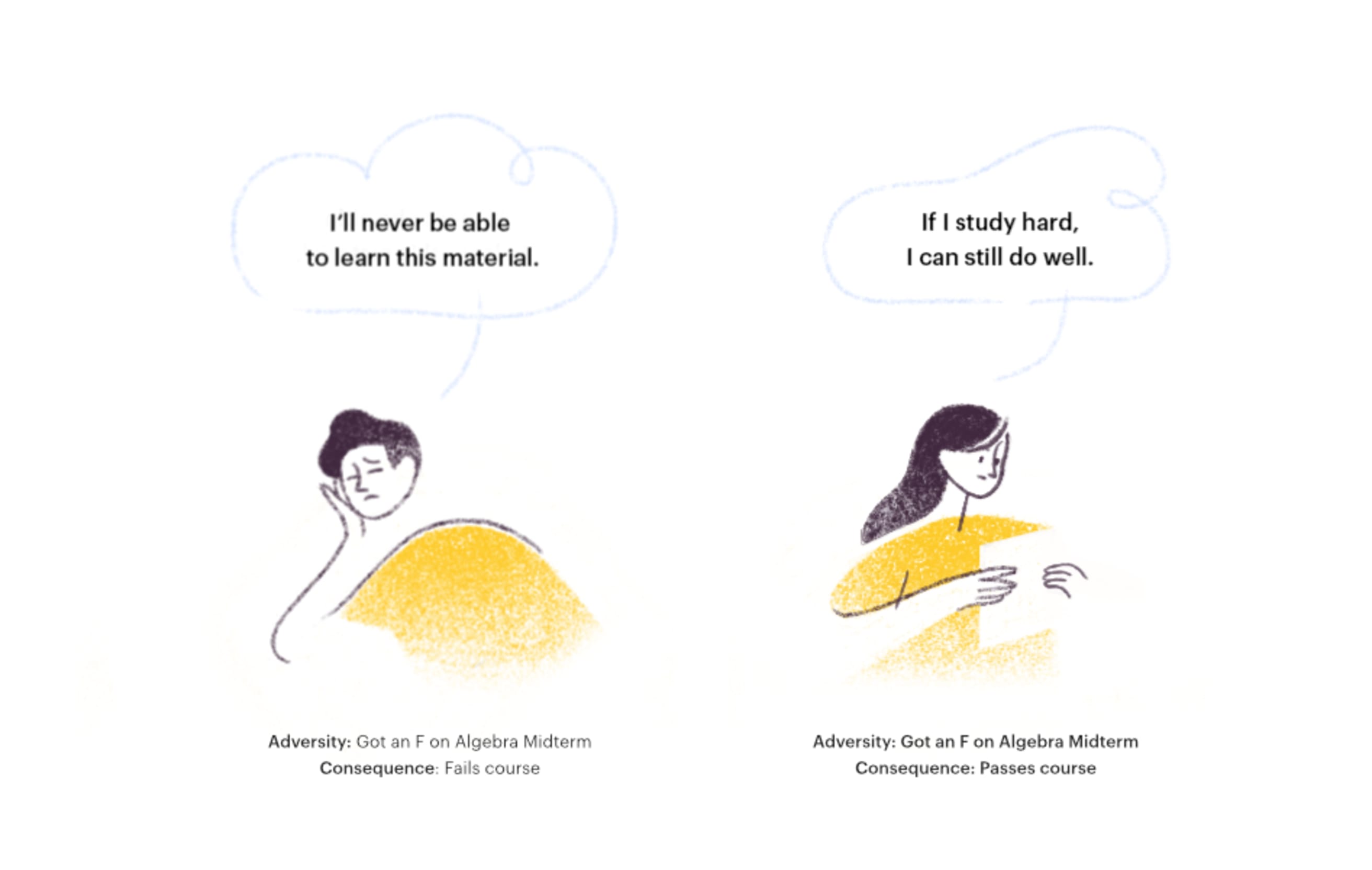The summer of 2013 was full of promise. I graduated from college with honors, spent a month traveling abroad and then moved across the country for graduate school in journalism — where I promptly fell flat on my face for basically the first time in my life.
School had always come easy to me, but grad school was a different story. I struggled in a way I never had before. I’d chosen a degree outside my main wheelhouse, and no matter how much I studied, academics weren’t simple anymore. I struggled with learning the best ways to report, to write, to tell a story — and especially with the edits and critiques that come as part of the field.
In hindsight, none of this was especially unique. They were challenges a lot of people face, and those lessons went a long way to making me a better writer. But I didn’t handle the stress very well. I earned my degree, but I cried at my graduation party, convinced I could never make a career out of the field I loved. There’s nothing quite like publicly sobbing into a piece of cake to really set the bar low.
The next day, I promised myself that I’d learn to be sturdier than whatever challenges came next. I called it ‘getting stronger,’ but what I was talking about was resilience.
The American Psychological Association (APA) defines resilience as the “the process of adapting well in the face of adversity, trauma, tragedy, threats or significant sources of stress — such as family and relationship problems, serious health problems or workplace and financial stressors.” Resilient people are more likely to bounce back from stressful or traumatic situations, and they demonstrate an optimistic attitude, opting to see the lessons in failure.
I’m sure as you read that, a few resilient people you know popped into your head. The person who goes through a nasty breakup but ends up making their life better for it. The one who gets laid off and, a year later, has somehow managed to reemerge stronger and happier than ever before.
If you’re anything like me, the grace with which these people greet some truly awful life events both inspires you and makes you a little — alright, a lot — envious. It’s a quality I admire — a quality I want. Luckily for me (and maybe for you, too), resilience isn’t something you’re born with, but something you build. Psychologists say it’s comprised of behaviors, thoughts and actions that anyone can learn — a skill that can be improved, just like running or speaking a new language.
A 2007 literature review in the Journal of Advanced Nursing evaluated 50 different scientific papers to explore personal resilience as a way to cope with job stress among nurses. Ask any nurse, and they’ll tell you taking care of others is a fast-paced, high-stakes job. The authors write that nurses specifically face excessive workloads, lack of autonomy, organizational issues like restructuring, and can even face bullying or violence.
Yet, the authors found that nurses could actively develop and strengthen their own personal resilience to better cope with all of those challenges through strategies like developing emotional insight and becoming more reflective. In the process, they made themselves happier and calmer, and they helped to improve their workplace and industry overall.
The science is still mixed on what exactly is the best way to go about building resilience. It turns out there’s no single path; the journey will be different for everyone, but studies do reveal some common patterns
Resilience is relying on others
Resilience might conjure up an image of a solitary figure stoically tackling the challenges thrown her way. But that couldn’t be farther from the truth. Resilience has a lot to do with leaning on the people around you and with developing strong, supportive connections. Friendships are shown to reduce stress and increase your lifespan.
For me, it’s about reaching out to other writers — from showing up to the writers’ group that meets for monthly beers to asking for advice from the mentors I’ve picked up along the way.
Take the extra 10 minutes in the morning to say hello to your co-workers. Bring someone along on your coffee run. Grab lunch on Friday, or show up to that happy hour you usually avoid. Outside the office, spend quality time with your friends and family, the people who will lift you up and bring you some much-needed perspective when things go awry. Alternatively, you could join a civic or religious group. Spend Saturday volunteering. Whatever it looks like for you, get to know the people in your community.
Resilience is trusting your own abilities
My friend, we’ll call her Lucy, has worked in fundraising for the last six years, but about a year-and-a-half ago, she left a high-paying position to pursue more meaningful work. She wound up at a nonprofit where she met with a lot of initial success. But a string of miscommunication about a potential raise resulted in a lot of interoffice tension, heightened by a small team and tight working quarters. It sent her reeling and left her questioning her decision.
“As someone who has always struggled to see my own value and worth, it was a huge blow. I was suddenly feeling like I didn’t deserve success,” she said.
She took a weekend to wallow, and by Sunday her self-pity had turned to frustration.
“I ended up writing a list of the number of donors and total donations I had raised during my time there, the total number of awarded grants that I had written and outlined all of the other progress that I made for the organization over the last six months. The following day, I went through this list with my bosses,” she says. “This list became my mantra. It reminded me of my value.”
A few months later, Lucy parted ways with the organization, but that list still comes in handy. Since then, she’s used her mantra of self-worth to negotiate a higher wage in a job she loves.
Gaining perspective and establishing trust in your own abilities can go a long way toward building resilience. Keeping a list of accomplishments you’re proud of can be a good reminder of times you’ve been resilient before — and the push you need to do it again.
Resilience is being kind to yourself
Self-care is one of those “it” concepts that gets a lot of attention right now. It’s easy for the word to lose all sense of meaning, but I’m going to write about it here, because it’s that important. And because it’s often the first thing that gets tossed out the window when things get hard.
The obvious basics can go a long way: exercise, sleep, and good food. But none of those habits will last long if you don’t give yourself permission to set boundaries — not just physical but also mental and emotional — between your work stresses and the rest of your life. You can shut down your computer and put away your phone at the end of the day, but it will do little good if you’re still worrying about the email you didn’t get to send.
An instructor at a professional development workshop once told me to visualize dropping off my workload and workplace worries at a designated spot on my commute home — to picture leaving them there and picking them up again in the morning on the way back to the office. I laughed when she said it, but tried it anyway. Now, at the end of every day, I leave my unwritten articles and unanswered emails in a heap in the middle of the roundabout just after my highway exit.

Similarly, author and computer science professor Cal Newport runs through a workplace shutdown ritual at the end of every day, which starts with updating his to-do list and ends with muttering, “Schedule shutdown, complete,” as he turns off his computer. Yes, he recognizes it’s a little cheesy, but saying the phrase out loud gives him permission to stop spending mental energy on any work-related problems for the evening.
Self care can look different for everyone. One friend collects postcards and lines her cubicle with them to remind herself of her favorite places. Another runs. My own favorite brands of self-care alternate between cardio dance class and reading a good book on my balcony.
Resilience is knowing you can change the stories you tell yourself
There are a lot of benefits to optimism. Studies suggest optimistic people are healthier, make more money and even fare better in relationships. It’s also a key component of resilience.
To change your outlook — and boost your capacity to deal with tough situations — the APA says to try to avoid seeing problems as insurmountable obstacles, to keep things in perspective and to accept that change is a part of life. Other sources suggest focusing on the silver linings, to try to find the good, the lesson or the opportunity for growth and self-discovery in every difficult situation.
That is, obviously, easier said than done.
Renee Jain, the founder of GoStrengths, which provides social and emotional learning programs to schools, suggests teachers use a concept called the ABCs of Resilience to teach their students about building a more resilient mindset.
Adversity + Belief = Consequence
Let’s say two students both fail their math test. If student X believes that one bad grade isn’t the end of the world and that studying will help, she’ll move forward with that action and likely get a better grade on the next test. If student Z thinks that getting one bad grade has ruined his chances at acing the class and there’s no point in trying, he won’t, and his grades will suffer even more.

“Optimistic and realistic belief systems combine to create a cornerstone of resilient mindsets,” Jain writes. “The great news is that once students learn the ABC model, they can hone in on their beliefs and begin fine-tuning them for greater optimism and accuracy.”
The key is remembering that, while you can’t always control the situation, you do have control over how you respond to it.
Resilience is taking the next step, even if it’s small
Maybe more important than cultivating optimism is acting on it.
A 2017 study in the Journal of Psychology by researchers from George Mason University found that hope — more than grit, gratitude, meaning in life, curiosity or the belief in the ability to control life outcomes — helped offset the impact of negative life events. Hope, here, is defined as “the ability to generate routes to reach goals and the motivation to use those routes.” In other words, hope is taking action in spite of obstacles. Of the almost 800 people included in the study, those who had a high degree of hope had higher levels of well-being (read: high life satisfaction and happiness, and low depression) than those who did not. People with high levels of hope proved the most resilient.
Licensed clinical psychologist Melanie Greenberg writes, “Hope involves having goals and pursuing them energetically and flexibly, finding many different pathways to getting positive results.” Greenburg lists some helpful tips for how to build hope, including making a list that includes a goal, steps to achieve it, potential obstacles and strategies to overcome them.
Similarly, the APA suggests that one concrete strategy to build resilience is setting realistic goals and then making moves toward accomplishing them — even if you’re tiptoeing. Turns out movement forward, any movement at all, is a good way to tackle fear, too.

| Goals | Steps | Obstacles | Strategies |
|---|---|---|---|
| •Learn to play guitar | • Find a guitar teacher • Search for great YouTube tutorials | •Too many options, overwhelming •Too expensive •Too time-consuming | •Ask friends for recommendations •Only look at teachers with 4.5/5 rating •Save money by packing a lunch to work •Wake up earlier on weekends |
| •Be more social | •Accept more invitations •Proactively reach out to friends •Go to meetups | •Feeling burnout from work •Overcome social anxiety | •Manage time more effectively •Practice self-care •Make the business case to my manager about hiring an intern •Start with one-on-one with friends •Book a therapy appointment •Read about coping mechanisms |
[/app_block_wide]My friend Miriam is a master at practicing forward momentum. Whip-smart, she works as a manufacturing engineer and is responsible for running and improving factory equipment. But when she started a new job two years ago, she found herself besieged by imposter syndrome.
“I felt like didn’t have the knowledge or skills I needed to do the job. I had a coworker who had been in her job for 15-plus years who clearly didn’t like me, had little faith in my ability to do my job and would question and undermine me, even though I was technically ‘higher up’ than her,” she said.
A supportive manager who believed in her skills helped a lot those first few months — so did her “fake it ’til you make it” attitude. She believed she could tackle the problems thrown her way, or at least acted like she believed it. She took action, reminding herself that it would all get easier with time. One success built on another, growing both her skill set and her resilience.
“I still have that feeling sometimes,” she says. “But building experience and asking for help are the biggest things that have made me successful at work.”
When I set out to do research for this article, I reached out to a lot of folks I consider strong and asked them to tell me about ways they handled difficult situations. The results surprised me. None of them considered themselves especially resilient and, when I finally convinced them they were, most were hesitant to talk on the record. Resilience is, by its nature, a squirmy, personal topic. It’s uncomfortable.
Turns out that’s sort of the point. Resilience can be built over time and anybody can do it, albeit in different ways. The catch is resilience is contingent upon adversity. Those difficult times? They’re not fun, but they’re where the magic happens.
Graduation — and that cringe-worthy, crying-in-the-kitchen meltdown — took place over three years ago. If anything, there’s more criticism, rejection and challenges in the professional world than there ever were in grad school, and while never fun, they’re a lot easier to handle than they used to be. That’s because both my writing and resilience have grown a lot since then, and I look forward to continuing cultivating both skillsets well into the future.

